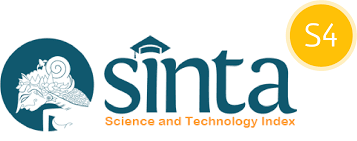Penerapan Algoritma Aprioti Pada Riwayat Data Kecelakaan Lalu Lintas
DOI:
https://doi.org/10.29408/jit.v5i1.4402Keywords:
traffic accident, association rule, apriori, minimum supportAbstract
With the increase of vehicle users, traffic accidents tend to happen more often. One of many ways to minimize the occurrence of traffic accidents is to process accident data history using data mining techniques. This technique is utilized in order to gain information regarding the relational pattern of traffic accidents. The data mining technique used is the association rule technique with the Apriori algorithm. One of the stages of analysis that has attracted the eyes of many researches to produce an efficient Apriori algorithm is analyzing the frequency pattern of an association that can be identified with two benchmarks; Support and Confidence. Currently, the determination of the minimum support value will be repeated by the user until it reaches a positive correlation value. This study applies a certain method to determine the minimum support value with the final result of achieving positive correlation on all datas as a reference for the lift ratio value >1 and getting 6 of the most frequent traffic accident patternsReferences
M. John and H. Shaiba, “Apriori-Based Algorithm for Dubai Road Accident Analysis,” Procedia Comput. Sci., vol. 163, pp. 218–227, 2019, doi: 10.1016/j.procs.2019.12.103.
R. N. D. C. Ratu, A. Pamuttu, and J. B. Bension, “Karakteristik Dan Pola Luka Korban Kecelakaan Lalu Lintas Di Rumah Sakit Bhayangkara Ambon Periode 2014-2017,” Molucca Medica, vol. 14, no. April, pp. 63–69, 2021, doi: 10.30598/molmed.2021.v14.i1.63.
A. Nursikuwagus and T. Hartono, “Implementasi Algoritma Apriori Untuk Analisis Penjualan Dengan Berbasis Web,” Simetris J. Tek. Mesin, Elektro dan Ilmu Komput., vol. 7, no. 2, p. 701, 2016, doi: 10.24176/simet.v7i2.784.
E. Hikmawati, N. U. Maulidevi, and K. Surendro, “Minimum threshold determination method based on dataset characteristics in association rule mining,” J. Big Data, vol. 8, no. 1, p. 146, Dec. 2021, doi: 10.1186/s40537-021-00538-3.
A. Sudianto and M. Wasil, “Penerapan Sistem Informasi Geografis dalam Pemetaan Sebaran Kasus Gizi Buruk Lombok Timur merupakan salah satu Kabupaten yang berada di Provinsi Nusa Tenggara Barat yang terletak di sebelah Timur Pulau Lombok , Kabupaten Lombok Timur Gizi Buruk Malnutrisi,” vol. 4, no. 2, pp. 142–150, 2021.
R. Fitria, W. Nengsih, and D. H. Qudsi, “Implementasi Algoritma FP-Growth Dalam Penentuan Pola Hubungan Kecelakaan Lalu Lintas,” J. Sist. Inf., vol. 13, no. 2, p. 118, 2017, doi: 10.21609/jsi.v13i2.551.
A. Zanuardi and H. Suprayitno, “Analisa Karakteristik Kecelakaan Lalu Lintas di Jalan Ahmad Yani Surabaya melalui Pendekatan Knowledge Discovery in Database,” J. Manejemen Aset Infrastruktur Fasilitas, vol. 2, no. 1, pp. 45–55, 2018, doi: 10.12962/j26151847.v2i1.3767.
E. D. Sikumbang, “Penerapan Data Mining Penjualan Sepatu Menggunakan Metode Algoritma Apriori,” J. Tek. Komput. AMIK BSI, vol. Vol 4, No., no. September, pp. 1–4, 2018.
M. Mahpuz, Y. Yahya, and M. Wasil, “Implementasi Algoritma Decision Tree Untuk Mengetahui Faktor Kredit Macet Dan Lancar Di Koperasi Serba Usaha Daruzzakah Rensing Lombok Timur,” Infotek J. Inform. dan Teknol., vol. 3, no. 2, pp. 92–103, Aug. 2020, doi: 10.29408/jit.v3i2.2299.
S. Suhartini and R. Yuliani, “Penerapan Data Mining untuk Mengcluster Data Penduduk Miskin Menggunakan Algoritma K-Means di Dusun Bagik Endep Sukamulia Timur,” Infotek J. Inform. dan Teknol., vol. 4, no. 1, pp. 39–50, Jan. 2021, doi: 10.29408/jit.v4i1.2986.
F. Rahmawati and N. Merlina, “Metode Data Mining Terhadap Data Penjualan Sparepart Mesin Fotocopy Menggunakan Algoritma Apriori,” PIKSEL Penelit. Ilmu Komput. Sist. Embed. Log., vol. 6, no. 1, pp. 9–20, 2018, doi: 10.33558/piksel.v6i1.1390.
A. Nastuti, “Amelia Nastuti 1 ) , Syaiful Zuhri Harahap 2 ),” Tek. Data Min. Untuk Penentuan Paket Hemat Sembako Dan Kebutuhan Hari. Dengan Menggunakan Algoritm. Fp-Growth, vol. 7, no. 3, pp. 111–119, 2019.
R. Yanto and R. Khoiriah, “Implementasi Data Mining dengan Metode Algoritma Apriori dalam Menentukan Pola Pembelian Obat,” Creat. Inf. Technol. J., vol. 2, no. 2, p. 102, 2015, doi: 10.24076/citec.2015v2i2.41.
M. I. Ghozali, R. Z. Ehwan, and W. H. Sugiharto, “Analisa Pola Belanja Menggunakan Algoritma Fp Growth, Self Organizing Map (Som) Dan K Medoids,” Simetris J. Tek. Mesin, Elektro dan Ilmu Komput., vol. 8, no. 1, pp. 317–326, 2017, doi: 10.24176/simet.v8i1.995.
E. Budiyati, Hurniningsih, and M. D. Lusita, “Implementasi Metode Algoritma Apriori Untuk Penempatan Buku Pada Rak Perpustakaan Stmik Jakarta Sti&K,” J. Inf. Syst. Informatics Comput., vol. 4, no. 1, pp. 30–39, 2020.
N. F. FAHRUDIN, “Penerapan Algoritma Apriori untuk Market Basket Analysis,” MIND J., vol. 1, no. 2, pp. 13–23, Jun. 2019, doi: 10.26760/mindjournal.v4i1
Downloads
Additional Files
Published
How to Cite
Issue
Section
License
Semua tulisan pada jurnal ini menjadi tanggung jawab penuh penulis. Jurnal Infotek memberikan akses terbuka terhadap siapapun agar informasi dan temuan pada artikel tersebut bermanfaat bagi semua orang. Jurnal Infotek ini dapat diakses dan diunduh secara gratis, tanpa dipungut biaya sesuai dengan lisense creative commons yang digunakan.
Jurnal Infotek is licensed under a Creative Commons Attribution 4.0 International License.
Statistik Pengunjung




